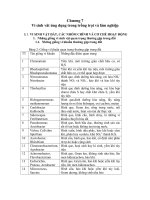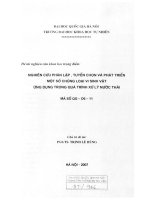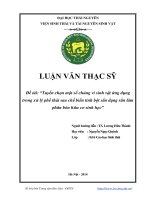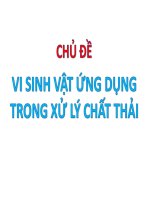VI SINH VẬT ỨNG DỤNG TRONG TRỒNG TRỌT - Applied Microorganims In Crop Productrion
Bạn đang xem bản rút gọn của tài liệu. Xem và tải ngay bản đầy đủ của tài liệu tại đây (21.03 MB, 103 trang )
<span class="text_page_counter">Trang 1</span><div class="page_container" data-page="1">
<b>VI SINH VẬT ỨNG DỤNG TRONG TRỒNG TRỌTApplied Microorganims In Crop Productrion</b>
<b>Mã học phần: BVVS533Số tín chỉ: 2</b>
<b>Lý thuyết: 21</b>
<b>Thảo luận, thực tập: 9</b>
</div><span class="text_page_counter">Trang 3</span><div class="page_container" data-page="3">ỨNG DỤNG VSV TRONG PHÒNG TRỪ BỆNH HẠI CÂY TRỒNG
L.N. Cương
</div><span class="text_page_counter">Trang 5</span><div class="page_container" data-page="5">• Thuốc hóa học
– Ảnh hưởng đến hệ sinh thái, môi trường, con người,…
<small>– Yêu cầu xử lý hàng năm</small>
<small>– Phổ tác động rộng nên ảnh hưởng đến cả VSV có ích</small>Nhưng:
• Tác nhân sinh học
<small>– Không độc với con người– Không ô nhiễm nước</small>
<small>– Có thể có hiệu lực kéo dài</small>
– Tính chọn lạc cao nên chỉ ảnh hưởng đến ít lồi sv có ích
Tại sao cần sử dụng vsv PTBC?
</div><span class="text_page_counter">Trang 6</span><div class="page_container" data-page="6"><b>Cơ chế phịng trừ sinh học bệnh cây</b>
<b>• Kháng sinh – kìm hãm sự phát triển đối tượng khác</b>
</div><span class="text_page_counter">Trang 7</span><div class="page_container" data-page="7"><b>• Cạnh tranh dinh dưỡng– C, N, O</b>
<sub>2</sub>, Fe, và các dinhdưỡng khác
– Khi đó có khả năng hạn chế vi sinh vật khác– Ví dụ:
<i>• P. fluorescens, VITCUS, ngăn chặn bệnh cháy xám khi cạnh tranhvới P. tolaasii</i>
<b>Cơ chế phòng trừ sinh học bệnh cây</b>
</div><span class="text_page_counter">Trang 8</span><div class="page_container" data-page="8"><i>• Trichoderma harzianum, BioTrek, </i>
<b>Cơ chế phịng trừ sinh học bệnh cây</b>
</div><span class="text_page_counter">Trang 12</span><div class="page_container" data-page="12"><b>Yêu cầu</b>
3. Các sản phẩm ứng dụng cần thể hiện đẩy đủ cácđặc điểm phòng trừ bệnh cây
a. Đảm bảo tác nhân sẽ phát triển tốt
<i><small>Coiling of Trichoderma around a pathogen. (Plant Biocontrol by Trichoderma spp. Ilan Chet, Ada </small></i>
<b><small>Viterbo and Yariv Brotman)</small></b>
</div><span class="text_page_counter">Trang 13</span><div class="page_container" data-page="13">• Cạnh tranh dinh dưỡng
• Được sử dụng như tác nhân phòng trừ sinh học vàkích thích sinh trưởng cây trồng
<small> class="text_page_counter">Trang 14</span><div class="page_container" data-page="14">
• Sự thay đổi gen
– Chủng hoang dại/ kẻ thù tự nhiên
• Khơng đồng nhất kiểu gen do đột biến
</div><span class="text_page_counter">Trang 15</span><div class="page_container" data-page="15">• Hầu hết các chủng hoang dại kháng với một số thuốchóa học. Tuy nhiên một số chủng khơng kháng.
• Các chủng sử dụng trong chế phẩm sinh học thươngmại được lựa chọn và thay đổi để kháng với một sốhóa chất nhất định.
<i><b>Phịng trừ bệnh cây bằng Trichoderma spp.</b></i>
</div><span class="text_page_counter">Trang 16</span><div class="page_container" data-page="16"><i><b>Phòng trừ bệnh cây bằng Trichoderma spp.</b></i>
</div><span class="text_page_counter">Trang 17</span><div class="page_container" data-page="17">• Hoạt động đối kháng với nấm bệnh
<small>1.Bao vây, tấn công sợi nấm</small>
<small>(Hubbard et al., 1983. Phytopathology 73:655-659).</small>
<i><b>Phòng trừ bệnh cây bằng Trichoderma spp.</b></i>
</div><span class="text_page_counter">Trang 18</span><div class="page_container" data-page="18">• Tác động đối kháng với nấm bệnh
<small>2. Xuyên vào thành tế báo do tạo rathủy phân enzymes</small>
<small>(Ilan Chet, Hebrew University of Jerusalem).</small>
<i><b>Phòng trừ bệnh cây bằng Trichoderma spp.</b></i>
</div><span class="text_page_counter">Trang 20</span><div class="page_container" data-page="20">• Một số sản phẩm thương mạiT-22
• Bao hạt, xử lý cây con
<i>• Giúp rễ hạn chế nấm Pythium, Rhizoctonia and Fusarium</i>
• Sống vùng rễ cây, cung cấp dinh dưỡng cho cây
<i><b>Phòng trừ bệnh cây bằng Trichoderma spp.</b></i>
</div><span class="text_page_counter">Trang 22</span><div class="page_container" data-page="22">Ứng dụng vsv trong quản lý sâu hại(sử dụng các vsv gây bệnh cơn trùng)
</div><span class="text_page_counter">Trang 23</span><div class="page_container" data-page="23">ĐỊNH NGHĨA
• Vi sinh vật gây bệnh côn trùng là các vsv ký sinh trêncôn trùng làm cho côn trùng bị nhiễm bệnh và chết.
– Các côn trùng bị vsv ký sinh gọi là ký chủ
– Các vsv gây bệnh cơn trùng có thể nhiễm tự nhiên gọi là kẻthù tự nhiên
• Khi các tác nhân gây bệnh côn trùng nhập nội đượcnhân nuôi và thả ra ngồi đồng ruộng để phịng trừmột đối tượng cơn trùng cụ thể gọi là tác nhân phịngtrừ sinh học
</div><span class="text_page_counter">Trang 24</span><div class="page_container" data-page="24"><small>• Viruses: Virus là có kích thước bé (nm), ký sinh bắt buộc, khơng cókhả năng di động hay trao đổi chất, nó bao gồm lõi nucleic acid, cóhoặc khơng có vỏ protein, </small>
<small>• Protozoa: Động vật nguyên sinh. • Nematodes: Tuyến trùng. </small>
</div><span class="text_page_counter">Trang 25</span><div class="page_container" data-page="25">VI KHUẨN
• Nhóm: Loại tạo bào tử và khơng tạo bào tử.
• Sinh sản: vi khuẩn có thể phát triển trong cơ thể CT*.
• Lây nhiễm: xâm nhập qua da hay miệng vào hệ thống tiêu hóa, của cơn trùng.
• Tồn tại: Một số tạo bào tử có khả năng tồn tài lâu dài. • Phổ ký chủ: Lepidoptera, Coleoptera và Diptera.
• Nuôi cấy: VK dễ nuôi cấy, tuy nhiên cần điều kiện đặc biệt đểhình thành bào tử.
<i>• Tác nhân phòng trừ sinh học: Chủ yếu là Bacillus, một số loại</i>
khác có thể gây hại trên các cơn trùng đã suy nhược
</div><span class="text_page_counter">Trang 26</span><div class="page_container" data-page="26"><i>Bacillus spp.</i>
<i><small>1. Bacillus thuringiensis: trong thời gian hình thành bào tử, vk sản sinh một</small></i>
<small>lượng lớn tinh thể proteinaceous. Hợp chất này hòa tan trong cơ thể cơntrùng hình thành nên polypeptides. Hầu hết Lepidoptera bị nhiễm, một sốchủng gây bệnh cho muỗi và bộ cánh cứng. Hiện nay chế phẩm Bt đượcsử dụng nhiều trên thế giới và nó cũng được xem là điểm khởi đầu chocây trồng biến đổi gen hiện nay. </small>
<i><small>2. Bacillus popilliae: Lồi này khơng tạo độc tố. Bào tử nằm trong đất nhiễm</small></i>
<small>vào sâu non qua ruột, phát triển trong ruột, một số xuyên qua màng ruộtvào máu của côn trùng. Sau 14-21 ngày cơ thể sâu hại bị chết, mềm và cómàu trắng, sau khi sâu chết, bào tử được giải phóng vào đất.</small>
<i><small>3. Bacillus sphaericus: Một số chủng có thể tạo độc tố gây chết ấu trùng mỗi; </small></i>
<small>một số chủng khác có thể diệt bằng các bào tử của nấm. </small>
</div><span class="text_page_counter">Trang 27</span><div class="page_container" data-page="27"><i><small>Bacillus thuringiensis viewed by phase contrast </small></i>
<small>microscopy. The vegetative cells contain </small>
<b><small>endospores (phase bright) and crystals of an insecticidal protein toxin (delta endotoxin).</small></b>
<b><small>milky spore disease</small></b>
<i><b><small>Bacillus popilliae Dutky</small></b></i>
</div><span class="text_page_counter">Trang 29</span><div class="page_container" data-page="29"><small>• Các nhóm: Nấm gây bệnh cơn trùng có thể thấy ở một số nhóm ví dụ như</small>
<i><small>Entomophaga grylli có vịng đời hồn tồn, cịn nấm Metarhizium and Beauveria chỉ cỏ giai đoạn vơ tính. </small></i>
<small>• Sinh sản: Tạo bào tử vơ tính hoặc hữu tính. </small>
<small>• Lây nhiễm: Bào tử nấm nảy mầm trên bề mặt cutin và xâm nhập vào trongdựa vào enzyme và cơ học. Khi vào máu nấm phát triển nhanh hình thànhsợi nấm, các dạng hợp bào có thể phát triển nhanh chóng trong cơ thể. • Cơ chế gây chết: Do sự phát triển của tản nấm, do ngạt hoặc đói, hoặc do </small>
<small>độc tố tạo ra trong pha lên men. • Tồn tại: Sợi nấm hoặc bào từ</small>
</div><span class="text_page_counter">Trang 30</span><div class="page_container" data-page="30">NHÓM NẤM GÂY BỆNH CƠN TRÙNG CHÍNH
<small>Sub-divisionsOrdersFamiliesExampleMastigomycotinaOomycetesLagenidiaceae</small> <i><small>Lagenidium</small></i>
<small>ChytridiomycetesBlastocladiaceae</small> <i><small>Coelomomyces</small></i>
<small>ZygomycotinaEntomophthoralesEntomophthoraceae</small> <i><small>Entomophaga and many </small></i>
<small>other generaMucoralesMucoroceae</small> <i><small>Sporodiniella</small></i>
<small>AscomycotinaClavicipitalesClavicipitaceae</small> <i><small>Cordyceps</small></i>
<small>HypocrealesHypocreaceae</small> <i><small>Cordycepioideus</small></i>
<small>LaboulbenialesLaboulbenioceaeMany generaPleosporalesPodonectriaceae</small> <i><small>Podonectria</small></i>
<small>BasidiomycotinaSeptobasidialesSeptobasidiaceae</small> <i><small>Septobasidium</small></i>
<small>Deuteromycotina (No formal </small>
<small>Hyphomycetes</small> <i><small>VerticilliumAspergillusBeauveriaMetarhizium</small></i>
<small>Coelomycetes</small> <i><small>Sorosporella</small></i>
</div><span class="text_page_counter">Trang 31</span><div class="page_container" data-page="31">Bộ: Entomophthorales
<small>• Sinh sản: Nấm GBCT có chu kỳ phức tạp có thể có chu kỳ phát triểnhồn tồn và khơng hồn tồn. </small>
<small>• Ni cấy: Một số nuôi cấy, tạo bảo tử, tuy nhiên một số khơng tạo bảo từ. </small>
<i><small>• Entomophaga maimaiga Được sử dụng rộng rãi ở châu Á và Nhật bản• Entomophaga praxibulli: được sử dụng ở mỹ trừ châu chấu</small></i>
<i>• Zoophthora radicans: </i><small>được sử dụng để trừ rệp. </small>
<i><small>• Entomophthora muscae: là kẻ thù tự nhiên của ruồi</small></i>
<i><small>• Neozygites floridana: được sử dụng trừ Mononychellus tanajoa trên sắn</small></i>
<small>ở Benin. </small>
</div><span class="text_page_counter">Trang 32</span><div class="page_container" data-page="32"><small>Overwintering resting spores </small>
<i><small>(azygospores) of Entomophaga </small></i>
<i><small>maimaiga. </small></i>
<small>Conidia of Zoophthora radicans</small>
<small>Sporangiophora and sporangium of Entomophthora</small>
<i><small>Neozygites sp.</small></i>
</div><span class="text_page_counter">Trang 33</span><div class="page_container" data-page="33">Bộ: Deuteromycetes
• Sinh sản: Phần lớn khơng sinh sản hữu tính hoặc chưa pháthiện giai đoạn hữu tính trong vịng đời của nấm.
• Ni cấy: Dễ dàng ni cấy trên mơi trường.
<i>• Metarhizium: M. anisopliae, là hai lồi phổ biến ở các nước</i>
nhiệt đới.
<i>• Beauveria: B. bassiana and B. brogniarti được sản xuất nhiều ở </i>
Trung Quốc, Châu Âu và châu Mỹ
<i>• Verticillium lecanii: Được sử dụng làm thuốc trừ sâu sinh học</i>
trong nhà kính ở Châu âu.
</div><span class="text_page_counter">Trang 34</span><div class="page_container" data-page="34"><i>Lồi: Metarhizium anisopliae</i>
<i><small>• Metarhizium anisopliae, cịn có tên là</small></i>
<i><small>Entomophthora anisopliae, được sử dụng rộng rãi</small></i>
<i><small>trong trừ sâu hại. Nấm M. anisopliae lần đầu tiên</small></i>
<small>được sử dụng là tác nhân phòng trừ sinh học năm1879, khi Elie Metchnikoff thí nghiệm trừ bọ cánh</small>
<i><small>cứng Anisoplia austriaca hại lúa mỳ. Sau đó được</small></i>
<small>sử dụng trừ bọ cánh cứng hại cây cải đường</small>
<i><small>Cleonus punctiventris.</small></i>
<i><small>• M. anisopliae được gọi là nấm xanh vì bào tử có</small></i>
<small>màu canh. Nấm có thể gây hại khoảng 200 lồi cơntrùng.</small>
<i><small>• M. anisopliae xâm nhập vào côn trung fthoong qua </small></i>
<small>lổ thở. Nấm phát triển trong cơ thể côn trùng sửdụng các nguồn dinh dưỡng để phát triển. Ngồi ranấm có thể sản sinh các hoạt chất gây độc cho côntrùng</small>
</div><span class="text_page_counter">Trang 36</span><div class="page_container" data-page="36"><i>Nấm trắng: Beauveria bassiana</i>
</div><span class="text_page_counter">Trang 37</span><div class="page_container" data-page="37"><small>• Là lồi nấm gây bệnh cho cơn trùng, có màu trắng, nên người Việt Nam và Trung Quốc gọi là nấm bạch cương.</small>
<small>• Bạch cương có sợi nấm màu trắng, đa bào, phân nhánh. Cơ quan sinh sản vơ tính là cành bào tử phân sinh, phân nhánh ziczac, hình cổ chai, trên đỉnh nhánh gắn các bào tử phân sinh đơn bào, hình trịn hoặc hình trứng, kích thước đường kính 1,5 - 5 mm. Nấm sinh độc tố Bôvêricin (Xyclo N - methyl L -phenylalanin - D a hydroxyl - isovaleryl). Bào tử </small>
<small>phân sinh nảy màm xâm nhập qua lớp vở chitin vào bên trong cơ thể cơn trùng.</small>
<i><small>• Lồi nấm Beauveria bassiana gây bệnh cho côn </small></i>
<small>trùng nên được sử dụng làm chế phẩm sinh học để phòng trừ sâu hại như rầy nâu, sâu rịm thơng...</small>
<small>• Ở chỗ nấm xâm nhập hình thành một chấm đen nhỏ trên da cơn trùng. Sau đó đám sợi nấm phát triển trong cơ thể côn trùng làm cho côn trùng chêt khơ cứng.</small>
<small>• Lồi nấm này cũng gây bệnh cho tằm gọi là bệnh tằm vôi.</small>
</div><span class="text_page_counter">Trang 38</span><div class="page_container" data-page="38"><i>Nấm trắng: Beauveria bassiana</i>
<i><small>• Nấm Beauveria bassiana phát triển trên cơ thể tằm </small></i>
<small>và côn trùng khác thành sợi nấm mọc rất nhanh rồi bao phủ kín bề mặt cơ thể lồi sâu hại. Sợi nấm xốp, cuống bào tử trần đứng riêng rẽ hoặc tụ lại thành đảm không phân nhánh hình ống hoặc bình vơi, chiều dài khơng đều nhau. Trên cuống có những nhánh nhỏ mang bào tử trần.</small>
<i><small>• Nấm Beauveria bassiana sinh những bào tử trần, </small></i>
<small>đơn bào khơng màu, trong suốt khơng vách ngăn, có hình cầu đến hình trứng. Cuống tế bào sinh bào tử trần hình ziczac, có mấu dạng răng nhỏ.</small>
<i><small>• Nấm Beauveria bassiana có chứa độc tố diệt cơn </small></i>
<small>trùng là beauvericin, đó là loại dexipeptid vịng có điểm sơi 93 - 94oC (từ 1 lít mơi trường ni cấy nấm Beauveria bassiana người ta tách được 1,5g độc tố beauvericin). Bào tử nấm bạch cương bay trong khơng khí dính vào cơn trùng, gặp điều kiện thuận lợi sẽ nảy mầm và mọc thành sợi nấm gây hại côn trùng.</small>
</div><span class="text_page_counter">Trang 39</span><div class="page_container" data-page="39"><i>Nấm tím: Paecilomyces farinosus</i>
</div><span class="text_page_counter">Trang 40</span><div class="page_container" data-page="40"><i>Nấm: Verticillium lecanii</i>
</div><span class="text_page_counter">Trang 41</span><div class="page_container" data-page="41"><small>• Tái tổ hợp: Virus tái tổ hợp trong tế bào chủ. • Lây nhiễm: Virus lây nhiễm qua miệng sau đó vỏ</small>
<small>bị hịa tan ở thành ruột, lõi thành dạng virion. </small>
<small>Dạng virion tài tổ hợp ở tế bào thành ruột, sau đóđi vào máu, tuyến nước bọt của cơn trùng. </small>
<small>• Gây chết: thường sau 10 ngày. </small>
<small>• Tồn tại: Sau khi chết, cơ thể sâu hại thành nangbao bọc virus và virus có thể tồn tại nhiều nămsau. </small>
<small>• Phổ ký chủ: Có phổ ký chủ hẹp, tuy nhiên một sốcó phổ ký chủ rộng. </small>
<small>• Ni cấy: Virus chỉ có thể ni cấy trong cơ thểsâu hại hoặc mơ tế bào. </small>
<small>• Các nhóm: Baculovirus, entomopox virus, picornavirus, cytoplasmic polyhedrosis virus. </small>
<small>• Tác nhân phịng trừ sinh học: Cho đến nay nhómvirus chính được biết đến là baculoviruses (hìnhtiếp theo). </small>
</div><span class="text_page_counter">Trang 42</span><div class="page_container" data-page="42"><i><small>Figure 1. </small></i>
<i><small>Generalized cycle of insect viruses. Figure credit: Jim McNeil, Department of Entomology, Penn State University.</small></i>
</div><span class="text_page_counter">Trang 43</span><div class="page_container" data-page="43">life-Virus cho đấu tranh sinh học sâu hại
<b><small>COMMODITYINSECT PESTVIRUS USEDPRODUCT</small></b>
<small>Apple, pear, walnut (ócchó) and plum (mận)</small>
<small>Codling moth (sâu đục quả)Codling moth granulosis virus</small> <b><small>Cyd-X 3)</small></b>
<small>Cabbage, tomatoes, cotton, (and see pests in next column)</small>
<small>Cabbage moth, American bollworm, diamondback moth, potato tuber moth, and grape berry moth</small>
<small>Cabbage army worm nuclear polyhedrosis virus</small>
<small>Vegetable crops, greenhouse flowers </small>
<i><small>Beet armyworm (Spodoptera exigua)</small></i>
<i><small>Spodoptera exigua nuclear </small></i>
<small>polyhedrosis virus</small>
<b><small>Spod-X (3)</small></b>
<small>Vegetables</small> <i><small>Celery looper (Anagrapha falcifera) </small></i>
<small>(Sâu đo hại rau cần)</small>
<small>Anagrapha falcifera nuclear polyhedrosis virus</small>
<small>Forest Habitat, Lumber</small> <i><small>Douglas fir tussock moth (Orgyia psuedotsugata)</small></i>
<i><small>Orgyia psuedotsugata nuclear </small></i>
</div><span class="text_page_counter">Trang 44</span><div class="page_container" data-page="44"><small>• Description: Baculoviridae are the safest insect viruses to use as </small>
<small>pathogens, since no similar viruses are known to infect vertebrates or plants. They have double-stranded DNA and are protected by a protein coat which improves their persistence. </small>
<small>• Infection: Infection occurs after susceptible insect larvae eat food </small>
<small>contaminated with virus. The virus then attacks the haemolymph, fatty tissue and mid gut. The insect becomes paralysed. </small>
<small>• Virulence: Highly virulent; the presence of very few particles can initiate infections and hosts die within 3-10 days. </small>
<small>• Susceptibility: The gut of the host insect must be alkaline so that the occlusion body can dissolve. </small>
<small>• Locusts: No baculovirus has been recorded from locusts with the </small>
<i><small>exception of an unconfirmed report of cross infection from a Spodoptera </small></i>
<small>sp. (Lepidoptera) host. </small>
<small>• Groups: Three groups of baculoviruses are described below: the nuclear polyhedrosis viruses, granulosis viruses and group C baculoviruses. </small>
</div><span class="text_page_counter">Trang 45</span><div class="page_container" data-page="45"><small>Rod-shaped virions are enveloped in the cell nucleus and occluded by a protein matrix</small>
<small>The occlusion bodies are highly resistant and can survive long periods in the environment</small>
</div><span class="text_page_counter">Trang 46</span><div class="page_container" data-page="46">Baculoviruses:
Nuclear polyhedrosis viruses (NPV)
<small>• Description: About 280 species known. Rounded cubic or hexagonal </small>
<small>polyhedra. 0.5-1.5 microns (µm) in size. Singly or multiply envelopped (see Figure 1). </small>
<small>• Infection: Infection occurs in the adipose* tissue of the hypodermis, in the tracheae and the middle intestine. </small>
<small>• Host: Approximately 120 species of Lepidoptera and Hymenoptera (particularly saw-flies). Each virus is highly specific to its host. </small>
<small>• Survival: Nuclear polyhedrosis viruses form particles inside a crystalline protein structure (occlusion body*). This allows the virus to survive outside the host for years out of sunlight. </small>
<small>• Biocontrol agents: The following NPVs have all been produced on a </small>
<i><small>commercial or semi-commercial scale: Autographa californica NPV, </small></i>
<i><small>Lymantria dispar NPV, Malacasoma disstria NPV, Mamestra brassicae NPV, Neodiprion sertifer NPV, Spodoptera NPV and Heliothis NPV </small></i>
</div><span class="text_page_counter">Trang 47</span><div class="page_container" data-page="47">survive outside the host. Can survive for years out of sunlight.
<i>• Biocontrol agents: Include Cydia pomonella GV (codling moth), </i>
<i>Phthorimaea operculella GV (potato tuber moth). </i>
</div><span class="text_page_counter">Trang 48</span><div class="page_container" data-page="48">Baculoviruses:
Group C Baculoviruses
<small>• NB This group of viruses is currently unclassified </small>
<small>• Description: Double stranded DNA. Viruses with non-included virions. Only visible using an electron microscope. 22-30 nm in size. These viruses are unusual since they have no protective protein coat to help them to survive. • Infection: These viruses attack the haemolymph*, fat body, mid-gut. Insects </small>
<small>become paralysed. </small>
<small>• Host: These viruses are restricted to Arthropoda. Larvae and adults of Coleoptera, Hymenoptera and mites. </small>
<i><small>• Biocontrol agents: Baculovirus oryctes:</small></i>
<i><small>• Used for the control of rhinoceros beetles, Oryctes spp. This virus is excreted </small></i>
<small>from the living diseased insect as virions*. These are passed on to other adults during mating. Some spread occurs from contamination of adult </small>
<small>breeding and larval feeding sites, but the virus does not survive long in the environment. </small>
</div><span class="text_page_counter">Trang 49</span><div class="page_container" data-page="49">Entomopox viruses
<small>• Description: Entomopox viruses have inclusion bodies (i.e. they are occluded* viruses) which are important for identification. Spherical or ovoid particles. 5-20 àm in size. </small>
<small>ã Infection: These viruses must be ingested by the host. They then attack the fat body. </small>
<small>• Virulence: They kill hosts more slowly than baculoviruses. • Host: Lepidoptera larvae, Diptera, Coleoptera, Orthoptera. • Survival: Little is known. </small>
<small>• Locusts: Entomopox viruses have been recorded from locusts and grasshoppers. </small>
<small>• Further information:</small>
<small>• class="text_page_counter">Trang 50</span><div class="page_container" data-page="50">
Động vật ngun sinh: PROTOZOA
<small>• Phân nhóm: Ciliophora, Sarcomastigophora, Apicomplexa, Microspora. </small>
<small>• Sinh sản: Chủ yếu sinh sản vơ tính. </small>
<small>• Phạm vi ký chủ: Nhiều loại cơn trùng, động vật, con người và đặc biệtcó thể ký sinh chun tính động vật chân đốt. </small>
<small>• Gây chết: Tác dụng chậm nhưng hạn chế nhân quần thể. • Xâm nhiễm: thường xâm nhập qua con đường thức ăn. • Tồn tại: bào tử. </small>
<small>• Ni cấy: trong cơ thể côn trùng sống. </small>
</div><span class="text_page_counter">Trang 51</span><div class="page_container" data-page="51"><small>In phase contrast, especially light refracting cysts are characteristic diagnostic stages of this pathogen, isolated from Malpighian tubules </small>
<i><small>of Locusta migratoria, (phase contrast, magn. </small></i>
<small>ca. 870x)</small>
<small>Giemsa-stained smear of spores (S) and </small>
<i><small>sporoblasts (Sb) of Nosema locustae (bright </small></i>
<small>field, magn. ca. 1540 x).</small>
<i><small>Extruded polar filament of a spore of Nosema </small></i>
<i><small>locustae, (phase contrast, magn. ca. 970 x).</small></i>
<i><b><small>Electron micrograph showing the ultrastructure of a spore of Nosema locustae. A anchoring disc, </small></b></i>
<b><small>PF polar filament, PP polaroplast, S sporoplasm, EN endospore, EX exospore, (magn. ca. 20,300 </small></b>
<small>Electron micrograph showing the </small>
<i><small>ultrastructure of a spore of Nosema locustae. </small></i>
<b><small>A anchoring disc, PF polar filament, PP </small></b>
<b><small>polaroplast, S sporoplasm, EN endospore, EX </small></b>
<small>exospore, (magn. ca. 20,300 x)</small>
</div>








